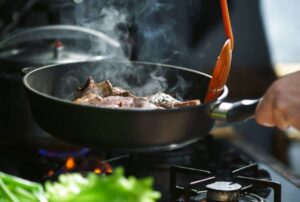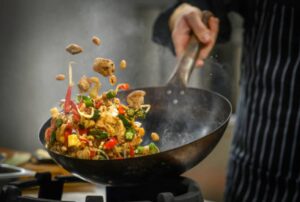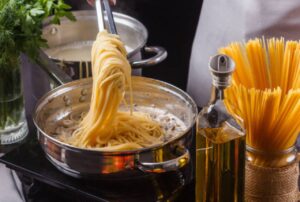Let me guess—you’ve been staring at that bubbling pot on your stove or that half-decent-looking salad in front of you thinking: “This could be better.” And you’re right. It could be better. In fact, almost any dish can go from meh to mouthwatering with one humble, often-overlooked ingredient.
No, it’s not truffle oil (although that stuff is fancy AF). And nope, it’s not MSG—though that’s a whole other conversation. The ingredient I’m talking about is acid. Yep. You read that right.
Don’t freak out—this isn’t a chemistry lesson. I’m talking about the kind of acid you already have in your kitchen: lemon juice, vinegar, balsamic glaze, pickled onions… the stuff that zaps your taste buds awake.
Let’s dive into why this ingredient is the secret weapon in almost every dish you love—and how to actually use it like a pro.
Why Acid is the MVP of Flavor
Ever made a dish that had all the right ingredients but still tasted kinda flat? Like a song missing the bass line? That’s what happens when you skip acid.
Acid adds brightness, contrast, and balance. It cuts through richness. It livens up dull flavors. It brings out the best in every other ingredient.
Honestly, acid is the Beyoncé of the flavor group. Without it, the rest of the band just doesn’t hit the same.
But Wait—What Even Is Acid in Cooking?
We’re not talking about battery acid (obviously). In food, acid means ingredients with a low pH—like:
- Lemon or lime juice
- Vinegars (white, apple cider, balsamic, rice… pick your fighter)
- Yogurt and buttermilk
- Tomatoes
- Wine
- Sour fruits like tamarind, pomegranate, or pineapple
They’re everywhere—you just didn’t realize they were doing all the heavy lifting behind the scenes.
How Acid Transforms Your Food (Without You Realizing)
It Brightens Flavors
Ever added a squeeze of lemon to soup and suddenly it tasted 10x better? That’s acid doing its thing. It doesn’t overpower—it enhances.
It Balances Salt and Sweetness
Too much salt? A dash of vinegar can tone it down. Something too sweet? Add citrus and boom—it’s balanced.
It Cuts Through Richness
Creamy pasta, fatty steak, cheesy anything—acid is the perfect counterpunch. That’s why a salad with vinaigrette works so well next to a heavy main dish. It gives your mouth a reset button.
How to Actually Use Acid Like a Flavor Wizard
Alright, theory is great and all, but let’s get practical. Here’s how you can sneak acid into your meals like a culinary ninja.
1. Finishing Touches: Always Taste Before You Serve
Before you serve anything, do this: taste it, then add a splash of acid, and taste again. You’ll be shocked at how much it wakes things up.
Try:
- A squeeze of lemon on roasted vegetables
- A drizzle of balsamic on grilled meat
- A few drops of vinegar in your soup or stew
2. Upgrade Your Sauces and Dressings
Making a salad dressing without acid is like throwing a party with no music—awkward and disappointing.
Quick vinaigrette ratio:
3 parts oil to 1 part acid (e.g., olive oil + apple cider vinegar)
Add mustard, honey, garlic, or herbs if you’re feeling extra.
3. Marinate Like You Mean It
Acid breaks down proteins and infuses flavor. So next time you marinate chicken, steak, or tofu, toss in:
- Lime juice for tacos
- Red wine vinegar for beef
- Yogurt for a killer chicken tikka
Pro tip: Don’t over-marinate with strong acids. It can make meat mushy. Aim for 30 minutes to a few hours, max.
Real-Life Food Makeovers Using Acid
I’ve made a lot of blah dishes in my life. Here are a few that acid saved from being tragically boring:
The Sad Soup Rescue
I once made lentil soup that tasted like wet cardboard. I was about to toss it when I squeezed in half a lemon—and I swear it was like someone flipped the flavor switch. Suddenly it was bright, savory, and addictive.
The Boring Roast Veggie Turnaround
Roasted veggies are great… until they aren’t. Toss them with a splash of sherry vinegar before serving, and you’ll actually want seconds.
The Rich Pasta Wake-Up Call
Carbonara is amazing. But sometimes it’s so rich you need a nap afterward. Add a squeeze of lemon juice and some grated zest—boom. Now it tastes gourmet and you can stay awake for dessert.
Pro-Level Acid Combos for Every Dish
You don’t need a culinary degree to get this right. Just try pairing the right acid with the dish and see what happens.
Here’s a cheat sheet to get you started:
For Meats:
- Steak: red wine vinegar or balsamic glaze
- Chicken: lemon juice, yogurt marinades
- Pork: apple cider vinegar or orange juice
For Veggies:
- Roasted carrots: lemon juice + honey
- Brussels sprouts: balsamic vinegar + mustard
- Asparagus: lemon zest + olive oil
For Grains:
- Rice or quinoa: squeeze of lime or splash of rice vinegar
- Pasta: lemon zest, white wine vinegar, or pickled shallots
For Desserts (Yep, Seriously):
- Fruit salad: lime juice + pinch of salt
- Chocolate: a whisper of balsamic
- Cheesecake: lemon zest in the filling
Bold flavors love bold acid. Don’t be shy.
Don’t Be That Person—Common Mistakes to Avoid
Okay, now that I’ve hyped up acid like it’s the second coming of flavor gods, let’s keep it real. You can mess it up. Here’s how not to:
1. Using Too Much
More isn’t always better. Acid should complement, not dominate. Start with a little—you can always add more, but you can’t un-pucker your face.
2. Using the Wrong Acid
Yes, there is a difference between lemon juice and balsamic vinegar. Not every acid works for every dish. Trust your taste buds—if it clashes, it clashes.
3. Adding Acid Too Early
In some cases (like vinaigrettes or ceviche), early is fine. But for soups, sauces, or anything hot, add acid near the end so the flavor doesn’t cook off.
So, Is Acid Really That Game-Changing?
In one word: YES.
It’s like discovering that seasoning your food with just salt is like texting in all lowercase—yeah, people get it, but they’re not exactly impressed. Add acid, and suddenly your dishes speak in full sentences, with exclamation points.
If you’ve ever wondered why restaurant food always tastes a little better—this is one of the big reasons. Chefs know acid is the key to balance and brightness. And now? So do you.
Final Thoughts: The Secret’s Out (Now Go Use It)
So next time your dish tastes a little… lifeless? Before you drown it in more salt or spice, reach for something acidic. A wedge of lemon. A dash of vinegar. A splash of wine. Whatever you’ve got.
It might just be the one thing standing between you and culinary greatness.
FYI: You don’t need fancy tools or ingredients. You just need to taste your food and trust your tongue. Seriously, cooking doesn’t have to be hard—it just has to be balanced.
Now, go give your meals a glow-up. And if someone compliments your food, just wink and say: “It’s the acid.”
You’ve got this.







